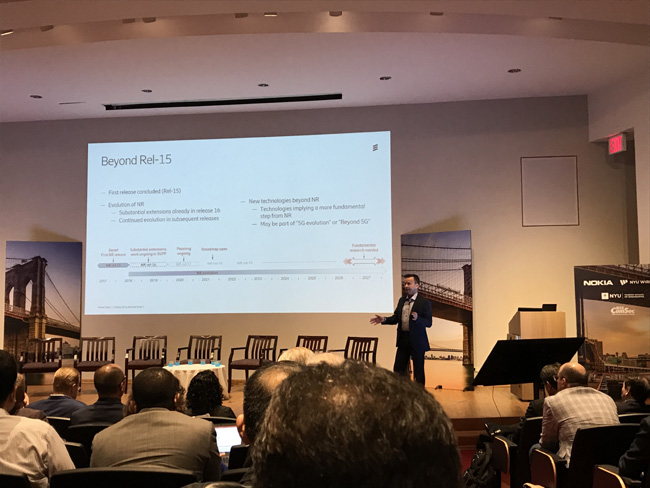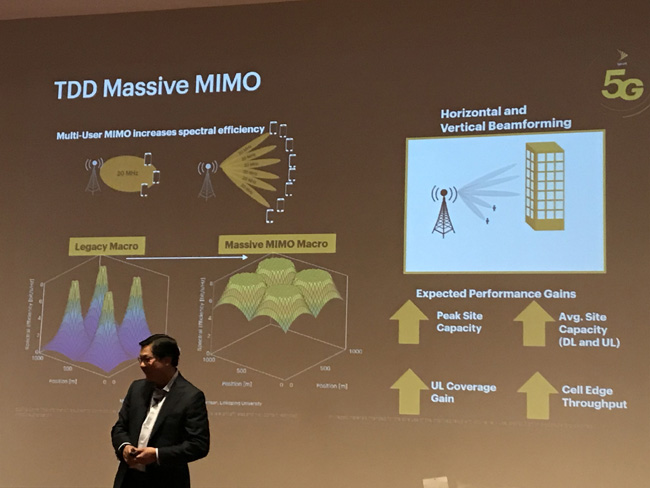The Brooklyn 5G Summit attracts almost all of the leaders in 5G research and development as the premier 5G annual event is hosted by NYUWIRELESS and Nokia on the NYU Campus. Leaders from both the operators and equipment manufacturers all attend and present their latest results and thoughts on the direction of the industry.
AT&T CTO, Andre Fuetsch, discussed the value of 5G which is a common question due to the high cost of implementation. He believes the primary value proposition is in the benefits to enterprise/industry applications that will collect data and provide valuable analytics and automation to decrease costs and increase productivity. He noted how AT&T deployed the first mobile 5G network in 2018 that is now available in 19 cities and will be nationwide by 2020. Their first devices achieved 1517 Mbps download speeds with 9 ms of latency which is good for their first deployment using mmWave spectrum and their Netgear puck device (Waco, TX).

In the press panel session, Michael Murphy of Nokia said they made their first 5G announcements at CTIA in 2016 and to date 30-35 operators have chosen Nokia equipment. According to Tommi Uitto of Nokia, 5G will have 3 inflection points: data/enterprise, cloud computing and machine learning. Last time that a cellular generation had this much impact was GSM when analog transitioned to digital and added data transmission to voice. Nokia echoed the primary 5G growth initially will come from enterprise applications and it is projected that industrial cell sites could double the number of current cell sites. Professor Yao Wang is working on video compression techniques to deliver video/gaming feeds from multiple angles as the users request using hundreds of cameras at the location of interest.

5G competitiveness was also a hot topic at the panel session and most view the US leading in mmWave, Korea/Japan in mid-band and China coming on strong later this year. The issue of safety came up too and NYU referenced a study they published in 2015 that showed that 5G was safe as sub-6 GHz signals are similar to the current 4G LTE signals used and mmWaves actually mostly get reflected off of the body (Ting Wu, Theodore S. Rappaport and Christopher M. Collins, “Safe for Generations to Come,” IEEE Microwave Magazine, vol 16, no 2, pp. 65-84, Mar 2015). mmWaves also don’t penetrate the skin very far and only manifest damage in heating of the skin so could be felt if the radiated power was high enough but the power levels are controlled to a safe level by the FCC in the US and similar agencies in other countries.
Mikael Hook of Ericsson took the stage and presented their status of 18 announced 5G deals around the world to date. These include US Cellular, AT&T, Verizon, Sprint and T-Mobile in the US and Vodafone UK, Telenor, Swisscom, TDC, Wind3, Ooredoo, STC, Batelco, Etisalat, KT, SK Telecom, Telstra, and Optus. He talked about how Rel 16 will extend 5G capabilities and that Rel 17 and 18 could be 5G Evolution or Beyond 5G. Some topics being discussed for Rel 16 are unlicensed spectrum (LAA and stand alone), CA/DC enhancements, remote interference management, V2X, integrated access backhaul, multi-antenna enhancements, URLLC enhancements and positioning. Possible Rel 17 topics include frequencies above the current 52.6 GHz bands, unlicensed spectrum (5-6 and 60 GHz), IAB enhancements, MIMO enhancements, public safety, drone enhancements, non-terrestrial access, NR MTC for industrial sensors and SON/MDT.

Dr. John Smee, VP Engineering at Qualcomm talked about new use cases and claimed the 5G mobile ecosystem is projected to drive greater than $12 Trillion in goods and services by 2035 (that is a long way off). He discussed how C-V2X is working with LTE so now they are working on 5G. 5G and beyond for Qualcomm is more about controlling, automating, computing rather than data transfer echoing what others said about 5G being different than previous generations.

The Future of 5G and beyond panel made the following points:
- Uplink speed needs improvement (we have only concentrated on downlink) and will need for this for effective IIoT
- More effort needs to be put into low band, uplink enhancement, and low power IoT
- MIMO/massive MIMO will be big improvement speed/capacity over 4G for 5G
- 80% of traffic today is off loaded to WiFi –Adopting unlicensed spectrum now but transmit power is limited so better for small cells
The best quote of the day was during the chairman’s panel - When we first heard that the 2020 Tokyo Olympics were going to have 5G, we said that is way to ambitious but now it will be the last 5G deployment!

John Saw, CTO at Sprint, discussed massive MIMO and low band networks. He noted that massive MIMO gives much better efficiency (mostly TDD). Sprint can cover a 50 story building with one massive MIMO basestation. They have built more than 1000 massive MIMO radios consisting of 128 elements (64T64R) at 2.5 GHz and they are smaller than regular basestations and easier to install. 32 LTE Massive MIMO sites were implemented at Super Bowl 53 and consumed 25 TB of data, a 157% increase from year before. 128 element arrays can do both LTE and 5G – half for each at 2.5 GHz – and have enough spectrum to do both at the same time. The user can take advantage of 128 MHz of bandwidth (NSA NR) with 3-4 X capacity for downlink and 9 X for the uplink (measured results). 5G is live in Chicago and they plan to launch in 9 cities in a couple of weeks.

Preorders for LG V50 are coming soon and HTC 5G Hub (4k HDR) & Galaxy S10 5G this summer. Sprint and T-Mobile can cover whole US with 2.5 GHz and 600 MHz if merger goes through he noted, of course.
Bill Stone, VP Technology and Dev. & Planning at Verizon, announced they have added 20 more cities (with a total of 30 this year). These include: Atlanta, Boston, Charlotte, Cincinnati, Cleveland, Columbus, Dallas, Des Moines, Denver, Detroit, Houston, Indianapolis, Kansas City, Little Rock, Memphis, Phoenix, Providence, San Diego, Salt Lake City and Washington, DC. They also announced that pre-orders for Galaxy S10 5G are available and touted the release of the world’s first 5G smartphone, the Moto Mod that is already available for order. He reinforced that Verizon was the first to deploy 5G mmWave service last Oct in 4 cities as home broadband service FWA at 28 GHz.
FCC commissioner, Michael O’Rielly, read a prepared speech that emphasized the need to allocate mid-band spectrum in the US as the rest of the world has pretty much allocated this band already. He said that some of the studies being required are unnecessary and wasting time to legalize these bands. He is against a national 5G network so wants it to remain free from gov’t control. He spoke out against the unfair practices of Chinese companies that are supported by gov’t funding as unfair for competition and raised the issue of security by being connected to the Chinese gov’t.

Professor Theodore Rappaport discussed 6G and beyond as his group is already doing channel sounding measurements at 140 GHz for possible 6G applications just as he paved the way for 5G mmWave applications at 28 and 73 GHz. Possible new applications exist for sensing, positioning, imaging, wireless cognition, and communication that are not possible today. He estimates that wireless computation rates by 2036 will approach the human brain so could “remote the human brain” around that time. He is characterizing 140 GHz signals for pass loss, penetration, scattering, blockage, etc. to model how they behave for future communication systems. He is excited that the FCC recently authorized frequencies from 95 GHz to 3 THz to be used for experimental work in future wireless applications and sees no theoretical problems with using operating frequencies to 700 GHz before running into issues that require further basic research. According to Prof. Rappaport, “5G will Work!”

